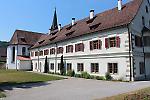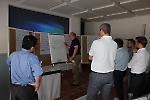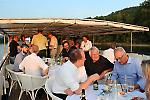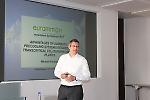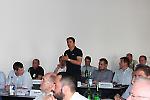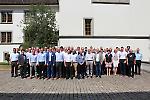Natural refrigerants: small applications with great potential
Frankfurt (Main), 10th July 2017 – The eurammon Symposium 2017 was held in Schaffhausen (Switzerland) on 22 and 23 June 2017. The speakers gave altogether ten lectures on current trends and developments in refrigeration and air-conditioning technology, with a special emphasis on "Small Applications <200 kW with Natural Refrigerants". As in previous years, the lecture event was fully booked with about 70 participants from 16 countries. "The European F-Gases Regulation and the Kigali agreement have brought natural refrigerants more than ever into the focus of the refrigeration and air-conditioning industry", explained Bernd Kaltenbrunner, Chairman of eurammon. "The growing demand for the classic large applications is currently also accompanied by a trend to using natural refrigerants in smaller plants with capacity of less than 200 kW – not just in refrigeration plants but also in heat pumps and air-conditioning systems", said Kaltenbrunner. Besides legal framework conditions and safety aspects, the key symposium topic also illustrated pioneering application examples. A special emphasis was placed on small applications with hydrocarbons such as propane.
Legal framework conditions, advanced safety standards and efficient plant design reinforce the use of natural refrigerants
The first day of the symposium looked at the environmental and safety requirements that have to be met by refrigeration and air-conditioning technology with natural refrigerants. Henry Wöhrnschimmel from the Federal Office for the Environment FOEN (Switzerland) informed the interested audience about the current legal situation in the symposium's host country, together with the pending second amendment of the Swiss Chemicals Reduction Ordinance (ChemRVV) with even stricter regulations on the use of synthetic refrigerants impacting on the climate. The environmentally friendly properties of natural refrigerants such as ammonia or CO2 therefore make them increasingly attractive for companies and operators.
The eurammon members Frank Rinne (Emerson Climate Technologies GmbH) together with Thorsten Lerch and Ralf Catanescu from the Federal Technical College of Refrigeration and Air Conditioning Technology (Bundesfachschule Kälte-Klima-Technik in Maintal, Germany) spoke on the safety requirements for natural refrigerants, showing optimum ways of implementing corresponding plants in the framework of the existing regulations. Fascinating details and insights into energy efficiency and profitability were provided in the lecture by Georges Hoeterickx (EVAPCO Europe BVBA), while Hermann Renz (BITZER Kühlmaschinen GmbH) presented the selection criteria for suitable components in commercial refrigeration systems with refrigerants R290 and R1270.
A look at successful practice – small applications are the next big thing
Attention particularly on the second day of the symposium turned to specific reference projects which were the subject of intensive discussions about relevant parameters such as plant design, component selection and operating costs. Johann Herunter (FRIGOPOL Kälteanlagen GmbH) and Kevin Dujardin (Alpiq InTec West AG) showed the impacts of phasing out various refrigerants on supermarket refrigeration, industry refrigeration and small business applications – examining why refrigeration systems with propane are an efficient, sustainable solution particularly in the small and medium capacity range.
Michael Freiherr (Güntner GmbH & Co. KG) illustrated the advantages of adiabatic air pre-cooling of gas coolers in trans-critical CO2 refrigeration plants for supermarkets, with various examples indicating the potential and the operating limits. Innovative, smart control functions for cutting operating costs and enhancing operational safety met with lively interest in the audience. The way a brewery in Munich's north-east cools and dries biogas in a liquid chiller with just 1 kg propane was demonstrated in the lecture given by Karl Huber (HKT Huber-Kälte-Technik GmbH). Ammonia is also growing increasingly significant as a refrigerant for HVAC and freezer systems: as shown in the lecture by Daniel McDougall (Star Refrigeration Ltd.), innovative DX technology makes it possible to reduce necessary refrigerant charge by up to 79% while still achieving the very high efficiency levels typical for ammonia systems.
It is no longer just existing and pending restrictions on synthetic refrigerants that drive the growing demand for systems that run on natural refrigerants. "The market is developing increasingly efficient components and improved system designs with low charge of refrigerants", explained Bernd Kaltenbrunner. "Besides future viability, the plants also score with higher efficiency and corresponding reductions in operational costs so that the initial investment soon pays off", said the eurammon Chairman. The growing number of successful reference projects in the <200 kW range also enhances an awareness for efficient applications that protect the environment and are suitable for long-term use, thus accelerating the market transformation towards using refrigeration and air-conditioning systems with natural refrigerants.
You`ll find the presentations of the speakers here.
Pictures:
Picture 1:
The eurammon Symposium 2017 was held in the picturesque Klostergut Paradies in Schlatt near Zurich in Switzerland.
Picture 2:
About 70 participants from 16 countries came to the eurammon symposium 2017.
Picture 3:
The programme was rounded off by altogether four interactive workshops where participants discussed the potential and currently existing hurdles relating to the use of natural refrigerants.
Picture 4:
Bernd Kaltenbrunner, Chairman of eurammon
Picture 5:
Dr. Frank Rinne
Picture 6:
Evening Boat Trip
Picture 7:
Evening Boat Trip
Picture 8:
Evening Boat Trip
Picture 9:
Michael Freiherr
Picture 10:
eurammon Symposium 2017: Day 2
Picture 11:
Interactive Workshop: Daniel McDougall
Picture 12:
eurammon Symposium 2017: 70 participants from 16 countries
